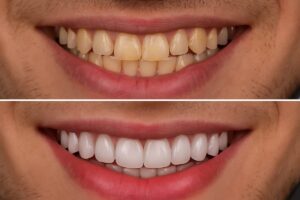Porcelain veneers are thin shells of ceramic bonded to the front of teeth to improve how your smile looks. They hide chips, stains, gaps, and small alignment problems while giving teeth a natural, uniform shape and color. If you’re researching porcelain veneers zanesville oh, this article explains what veneers are, who makes a good candidate, the step-by-step procedure, recovery and care, risks, costs, and how to schedule a consultation or virtual smile review. By the end, you’ll know what to expect before, during, and after treatment.
What Are Porcelain Veneers?
Porcelain veneers are custom-made ceramic shells that cover the front surface of teeth. Compared with composite bonding, porcelain offers better stain resistance and a more lifelike translucency. Veneers are different from crowns because they usually require less tooth removal and focus on improving appearance rather than restoring large areas of a tooth. Common materials include feldspathic porcelain and lithium disilicate, both chosen for strength and a natural look.
Who Is a Good Candidate for Porcelain Veneers in Zanesville, OH
Common cosmetic concerns veneers address
Veneers work well for people with chips, stubborn stains that don’t respond to whitening, small gaps, uneven tooth shape, or mild crowding. They can quickly create a balanced, bright smile when the underlying teeth are mostly healthy.
Oral health requirements
Candidates should have healthy gums and no active tooth decay. Your dentist will check for gum disease, cavities, and bite problems before recommending veneers. In some cases, fillings, periodontal care, or minor restorative treatment must be done first to ensure a stable foundation.
When to consider alternatives
If staining responds to whitening, bleaching may be a less invasive option. For minor chips, dental bonding can be faster and less costly. If teeth are badly misaligned, orthodontics like Invisalign could be a better long-term choice. Crowns are preferred when a tooth needs more structural support than a veneer can provide.
The Porcelain Veneers Procedure: Step-by-Step
Consultation and planning
Your first visit focuses on goals and planning. The dentist will take photos, digital scans, and discuss shade and shape. Many offices use smile-design software or mockups so you can preview results. This step sets realistic expectations and a treatment plan.
Tooth preparation and impressions
Most veneers require a small, conservative enamel reduction to make room for the shell. After prepping, the dentist takes digital or physical impressions to send to the lab. Temporary veneers may be placed while the lab fabricates the final pieces, which usually takes one to two weeks.
Final placement and bonding
At the final visit, veneers are tried on to check fit and color. The dentist makes small adjustments, then cleans and etches the tooth before bonding with a strong adhesive. You may feel pressure during placement but little pain. Each tooth visit can take 60–90 minutes; multiple teeth may be completed over one or two appointments.
Aftercare, Recovery, and What to Expect Immediately
Expect mild sensitivity to hot or cold for a few days after placement. Stick to soft foods for 24–48 hours and avoid very sticky or hard foods while bonding fully sets. Most people return to normal chewing within a day or two. A short follow-up visit is common to confirm fit, bite, and comfort.
Maintenance and Longevity of Porcelain Veneers
With proper care, porcelain veneers often last 10–15 years or longer. Brush twice daily with a non-abrasive toothpaste, floss daily, and see your dentist for regular cleanings and checkups. Avoid using teeth as tools, chewing ice, or biting very hard objects. Nightguards can protect veneers if you grind your teeth.
Risks, Downsides, and How to Minimize Them
Risks include short-term sensitivity, possible color mismatch, or margin issues where the veneer meets the tooth. Veneers are not reversible if significant enamel is removed. Choosing a skilled provider who uses a conservative prep, high-quality lab work, and digital planning reduces these risks. Regular dental care and avoiding bad habits help prevent damage.
Cost, Insurance, and Financing for Porcelain Veneers in Zanesville, OH
Cost varies by number of teeth, lab quality, and preparation needed. Single veneers cost more for higher-quality porcelain and custom shade matching. Insurance often treats veneers as cosmetic and may not cover the full price, though limited coverage for restorative reasons is possible. Many practices offer financing plans, third-party patient financing, or in-office payment options to spread costs over time.
Why Patients Choose Woodlawn Dental Center for Veneers
For patients near Zanesville, OH, Woodlawn Dental Center offers a team approach with digital workflows that improve fit and predictability. The practice emphasizes minimally invasive, precision dentistry and cosmetic expertise from providers like Dr. Gregory Harris Jr., who focuses on esthetic outcomes and digital smile design. Their mix of restorative and cosmetic skills helps deliver durable, natural-looking veneers.
How to Schedule a Consultation for Porcelain Veneers Zanesville, OH
Bring photos of smiles you like and be ready to discuss your goals, budget, and any dental history. The first visit usually includes an exam, digital photos or scans, and a treatment plan with cost estimates and timelines. If you’re curious about how veneers could change your smile, book a consult or virtual smile review to see options tailored to you.





